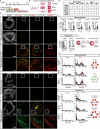Proof of concept for brain organoid-on-a-chip to create multiple domains in forebrain organoids
- PMID: 39911547
- PMCID: PMC11797153
- DOI: 10.1039/d4ra04194a
Proof of concept for brain organoid-on-a-chip to create multiple domains in forebrain organoids
Abstract
Brain organoids are three-dimensionally reconstructed brain tissue derived from pluripotent stem cells in vitro. 3D tissue cultures have opened new avenues for exploring development and disease modeling. However, many physiological conditions, including signaling gradients in 3D cultures, have not yet been easily achieved. Here, we introduce brain organoid-on-a-chip platforms that generate signaling gradients that in turn enable the induction of topographic forebrain organoids. This creates a more continuous spectrum of brain regions and provides a more complete mimic of the human brain for evaluating neurodevelopment and disease in unprecedented detail.
This journal is © The Royal Society of Chemistry.
Conflict of interest statement
The University of California, Irvine (MW and KK) obtained a US patent (Patent No. US12054698B2) on the brain organoid-on-a-chip devices. The rest of the authors declare no competing interests.
Figures


Update of
-
Brain organoid-on-a-chip to create multiple domains in forebrain organoids.bioRxiv [Preprint]. 2023 Sep 18:2023.09.18.558278. doi: 10.1101/2023.09.18.558278. bioRxiv. 2023. Update in: RSC Adv. 2025 Feb 5;15(5):3749-3755. doi: 10.1039/d4ra04194a. PMID: 37781620 Free PMC article. Updated. Preprint.
References
-
- Watanabe M. Buth J. E. Vishlaghi N. de la Torre-Ubieta L. Taxidis J. Khakh B. S. Coppola G. Pearson C. A. Yamauchi K. Gong D. Dai X. Damoiseaux R. Aliyari R. Liebscher S. Schenke-Layland K. Caneda C. Huang E. J. Zhang Y. Cheng G. Geschwind D. H. Golshani P. Sun R. Novitch B. G. Cell Rep. 2017;21:517–532. doi: 10.1016/j.celrep.2017.09.047. - DOI - PMC - PubMed

